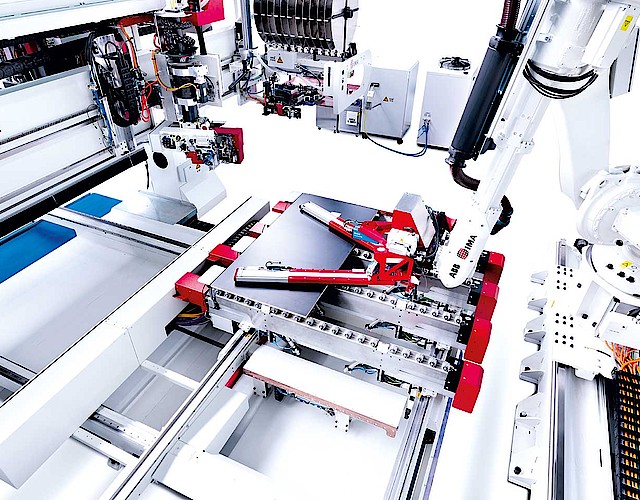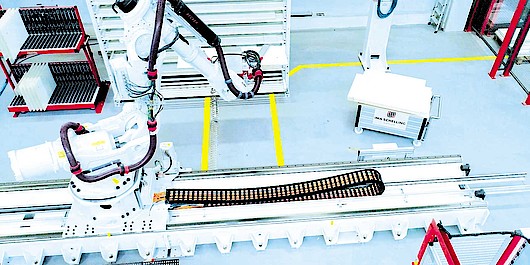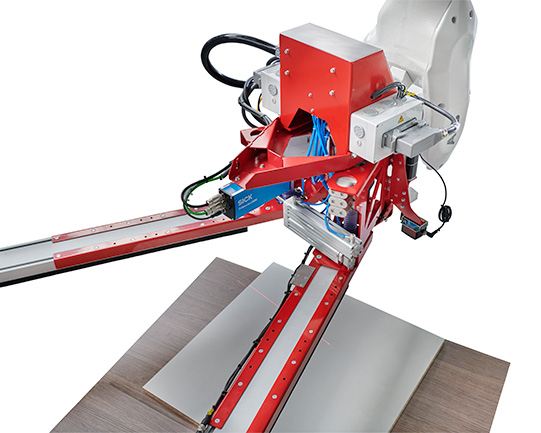

Robots are taking up more and more space in production – including in the furniture industry.
Will they bring about a whole new way of manufacturing?

The robot takes the board from the trolley and places it on the conveyor belt. From there it moves to the automatic drilling machine, receives the necessary holes and returns to the robot, which deposits it in the correct place on the sorting racks. IMA Schelling has installed a robot test rig for its customers at the Lübbecke site. A 6-axis robot that moves on a linear traversing axis can be used to run through scenarios for handling with robots, simulate material flows and predetermine the cycle times of individual processes.
According to the International Federation of Robotics (IFR), the number of industrial robots installed worldwide tripled between 2010 and 2019, and there are currently around three million worldwide.
Robots are also becoming increasingly important in the furniture industry. “In 2013 we presented the first applications at trade fairs,” explains Thomas Herold, Head of Development Handling and Transport. “Today, with our technology partner ABB, we configure up to 30 robot applications per year for our customers.” And the trend is rising.


Why? “Traditionally, robots take on three types of task:” explains Jan Frederik Bode, Product Manager Robotics at IMA Schelling, “the dangerous, unergonomic and monotonous ones.” And there are quite a few of these in furniture production. “Just think of boards that weigh 50 or 100 kilos!”
Not only are they difficult for a human employee to carry, but the requirements for how much weight employees are allowed to lift are also being tightened, says Bode. “The robot can easily transport heavy boards with consistent quality over a long period of time. It also documents exactly where it placed them. Keyword: process control.”
Handling robots reduce the processing times and thus increase efficiency and reliability with regard to delivery deadlines. Integration of robots into the production control system helps to ensure that deliveries are complete. Even with the increasing customisation in the furniture industry, robots bring advantages and help to maintain profitability. Batch-size-one production would scarcely be possible without automation. “Robots enable unstaffed production – 24/7 and with consistent quality,” emphasises Bode.
However, one should not equate automation with the use of robots, Herold emphasises: “We have many other technologies that we can use to drive automation, although perhaps not in such a convenient and flexible way.”
Availability, performance and quality – these are the key parameters of industrial production. And by enabling improvements in all three, robots also increase overall equipment effectiveness (OEE), the key figure for assessing the added value in production.
So do robots only offer advantages? Not exactly. “First of all, an initial investment is required,” explains expert Jan Frederik Bode. Not just financially, but also in terms of know-how. The employees have to be trained on how to handle the robots, and the robots have to be implemented in the existing production system. In addition, consistent data structures need to be available. This is the only way to ensure that the robot has the information about what part is in front of it and what to do with it.
There could also be problems in the operation of the automation units. “Robots reach their limits when they need to react to something unexpected,” emphasises Thomas Herold. Crooked stacks or undefined part positions, for example, can be detected via cameras and sensor systems, but are often not processed reliably.

Robots are unlikely to eliminate human jobs. For one thing, there are too many specific challenges in furniture production that require the creativity and spontaneity of a human employee. For another, the economic facts speak against it. According to calculations by the Centre for European Economic Research (ZEW), 1.6 million jobs were lost in Europe between 1999 and 2010 as a result of digitisation and robotics, while 3 million new ones were created.
And what does the future of robotics in the furniture industry look like? Several developments are emerging. Once robots are widespread in production, the next field of application is logistics. The robots themselves will also evolve. They’ll certainly evolve in the direction of collaborative robots, so-called cobots, which work directly with people. What’s more, robots could be equipped with even more intelligent sensor systems, complex image processing technology and artificial intelligence in the future. The systems could then also train themselves to react appropriately to unexpected events.